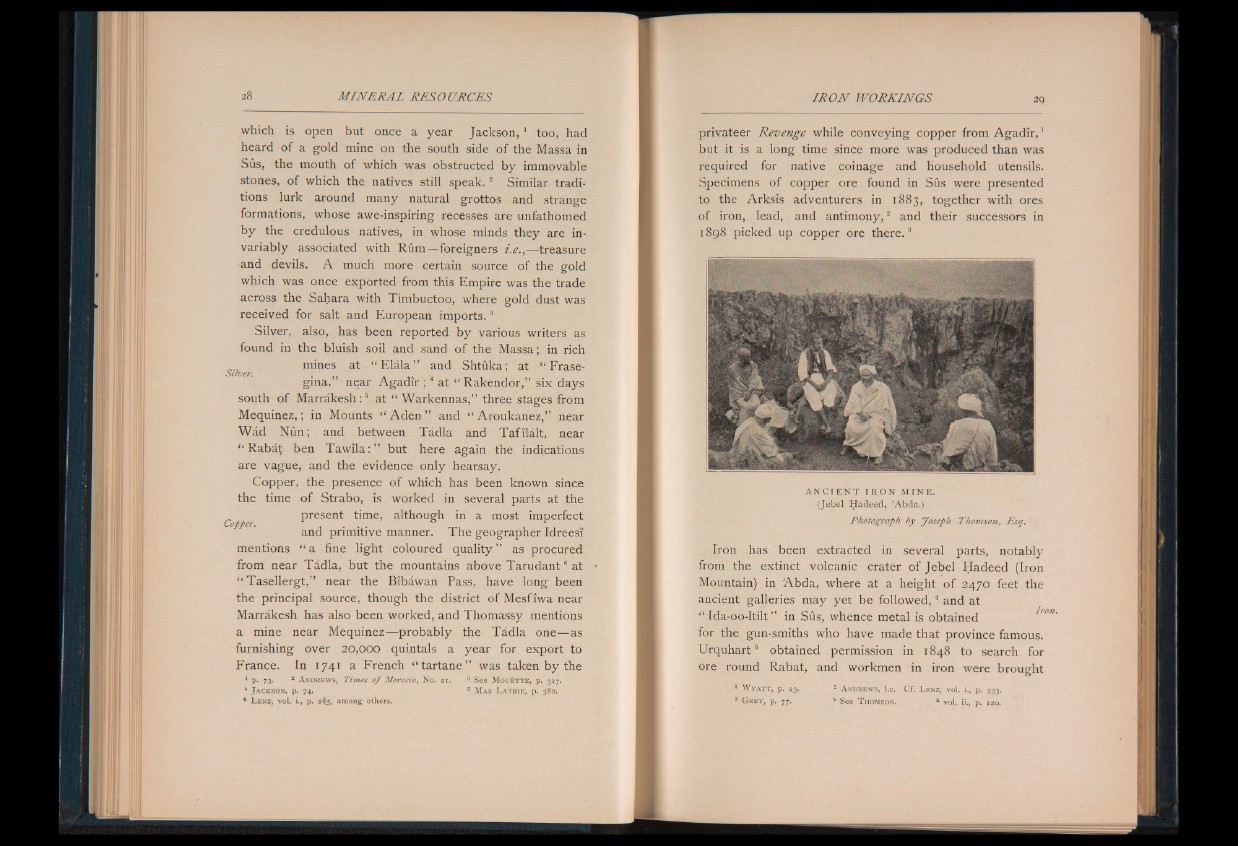
which is open but once a year Jackson, 1 too, had
heard of a gold mine on the south side o f the Massa in
Sus, the mouth of which was obstructed by immovable
stones, of which the natives still speak.2 Similar traditions
lurk around many natural grottos and strange
formations, whose awe-inspiring recesses are unfathomed
by the credulous natives, in whose minds they are invariably
associated with Rum—foreigners i.e.,— treasure
and devils. A much more certain source of the gold
which was once exported from this Empire was the trade
across the Sahara with Timbuctoo, where gold dust was
received for salt and European imports.3
Silver, also, has been reported by various writers as
found in the bluish soil and sand o f the Massa; in rich
mines at “ Elala I and Shtuka; at “ Frase-
Iver. . \
gma, near Agadir ; at “ Rakendor,” six days
south of Marrakesh:4 at “ Warkennas,” three stages from
Mequinez,; in Mounts “ A d e n ” and “ Aroukanez,” near
Wad Nun; and between Tadla and Tafilalt, near
“ Rabat ben T aw ila :” but here again the indications
are vague, and the evidence only hearsay.
Copper, the presence of which has been known since
the time o f Strabo, is worked in several parts at the
present time, although in a most imperfect
and primitive manner. The geographer Idreesi
mentions “ a fine light coloured quality” as procured
from near Tadla, but the mountains above Tarudant6 at
“ Tasellergt,” near the Bibawan Pass, have long been
the principal source, though the district of Mesfiwa near
Marrakesh has also been worked, and Thomassy mentions
a mine near Mequinez— probably the Tadla one— as
furnishing over 20,000 quintals a year for export to
France. In 1741 a French “ tartane” was taken by the
1 p . 73. 2 A n d r e w s , Times o f Morocco, N o . 2 1 . 3 S e e M o u e t t e , p. 3 17 .
4 J a c k s o n , p . 74. 5 M a s L a t r i e , p . 380.
6 L e n z , v o l. i., p. 28.5, am o n g o th e r s .
privateer Revenge while conveying copper from A g ad ir ,1
but it is a long time since more was produced than was
required for native coinage and household utensils.
Specimens of copper ore found in Sus were presented
to the Arksis adventurers in 1883, together with ores
of iron, lead, and antimony,2 and their successors in
1898 picked up copper ore there.3
A N C I E N T I R O N M I N E .
(Jebel Hadeed, ’Abda.)
Photograph by Joseph Thomson, Esq.
Iron has been extracted in several parts, notably
from the extinct volcanic crater of Jebel Hadeed (Iron
Mountain) in Abda, where at a height of 2470 feet the
ancient galleries may yet be followed,4 and at
“ Ida-oo-ltilt ” in Sus, whence metal is obtained
for the gun-smiths who have made that province famous.
Urquhart4 obtained permission in 1848 to search for
ore round Rabat, and workmen in iron were brought
1 W y a t t , p. 23. 2 A n d r e w s , I.e. Cf. L e n z , v o l. i ., p . 333.
3 G r e y , p . 77. 4 S e e T h om so n . 6 v o l. ii., p . 120.